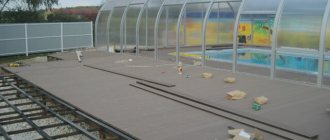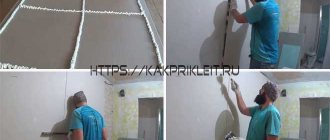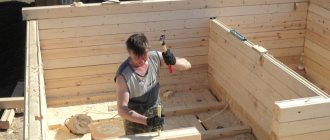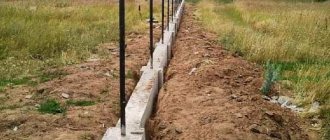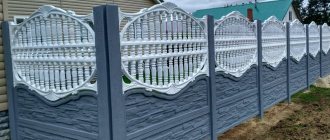Types and features of installing snow guards
There are two types of snow retainers based on design features - snow cutters and snow barriers.
Snow cutters
Snow cutters divide the snow mass into small fragments, which, when leaving the roof, do not pose a danger to people or property. Their task is to ensure the gradual descent of the snowball. Features of snow cutters:
- The design is tubular or lattice.
- Installation on the roof will help make snow melting as safe as possible, but it is not able to protect against it.
Main types:
- Lattice structures are effective and can withstand significant loads. However, they do not contribute to the gradual safe descent of masses, but keep them on the roof, which results in a lot of snow on the surface. This negatively affects the strength and service life of the coating. They are installed at a significant angle.
- Tubular ones are universal and can be installed on any type of coating, but most often snow retainers are mounted on corrugated sheets and metal tiles. They hold the snow on the roof, and by passing it between the tubes, they allow for gradual removal. It is safe for both people and the roof. The structure itself consists of brackets connected by parallel pipes. Suitable for roofs with a slight slope made of corrugated sheets, metal tiles, ondulin, and soft-covered roofs.
Step-by-step algorithm for installing tubular snow guards:
- Determine the location of the structure on the slope, focusing on the level. By stretching the paint cord between the extreme points, you can achieve a straight line.
- Mark the locations for placing fasteners and make holes with a metal drill. In this case, you cannot drill the sheathing; grooves are made only in metal tiles or corrugated sheets.
- Install the brackets, secure them using rubber gaskets between the roof and the bracket.
- Pull the pipes through the brackets and insert plugs into them.
If the pipe needs extension, then the elements are joined together using a tongue and groove fastening. The procedure for installing plate snow stops is similar, but instead of pipes, perforated plates are used.
Snow barriers
Snow barriers hold a lot of snow and ice on the roof surface, preventing them from melting until they completely melt.
Construction types:
- corner;
- yokes.
Angled ones are not able to cope with significant snow masses, therefore they are used in those regions where the precipitation rate is low. Fastening to a metal sheet, and not to the sheathing, therefore, when a large amount of snow melts, the element can be torn out along with a fragment of the covering.
Corner elements are mounted on metal tiles if the angle of inclination is within 20-30 degrees (the latter is permissible with light snow loads). The height of the element is 7-10 cm, the length is in the range of 200-300 cm. Corner snow guards are attached with self-tapping screws.
It is important to place structural elements above the load-bearing wall to maintain the integrity of the latter. To optimize the load, they are arranged in a checkerboard pattern between the corners.
Pointed snow barriers, or yokes, are additional; by themselves, they cannot provide real protection from snow masses. The only exception is a rough roof with a slight slope that holds snow well. They are also installed subject to regular roof cleaning.
Installation rules:
- The interval in width is 0.5 m, in length – 10-15 cm.
- Marking is required. Then the holes are drilled and the yokes are fixed with self-tapping screws.
- The elements are placed directly under the roof, so their installation is carried out in parallel with the installation of corrugated sheeting or other covering.
- Yokes equipped with a hook cling perfectly to the sheathing, eliminating the need for self-tapping screws.
Types of snow guards
Thanks to them, the roof becomes convenient for self-cleaning (each element can withstand the weight of a person). The system helps evenly distribute snow masses even during precipitation and prevent their uncontrolled melting. Snow catchers can protect against falling tiles or tools.
Based on functionality they are divided into two groups:
- Partially blocking. They do not completely retain the snow, but let it through in small portions. Installation is advisable in areas of central Russia, where the roof is under heavy load after a snowfall. To ensure gradual passage, it is better to choose snow retainers of the plate, lattice or tubular type.
- Snow barriers. Installed in areas with milder climates. If a metal roof accumulates a small layer of snow, it makes sense to block it completely.
- Spot. Modern devices, called snow stoppers, snow cutters or yokes, distribute snow along the slopes and reduce the load on the rafter system.
A metal tile roof has a wavy profile, so not every type of snow retainer can be installed on it.
1. Snow barrier tubes. They are made of steel or aluminum with a diameter of 20-35 mm with polymer coating; the kit also includes fasteners in the form of brackets. It is advisable to place the tubes in one line along the cornice. The instructions allow their use even if the roof has been in use for a long time.
2. Corner (plate) snow barriers. They are long metal strips, most often curved in the shape of a triangle. Usually they are bought complete with tiles, they are painted in the same color. Installation is carried out using self-tapping screws. The price of the devices is low, and the performance is quite high if the slope is no more than 15°.
3. Spot snow stoppers. They are made by stamping, so that the finished products repeat the wave shape of the tiles and fit better to the roof. Another option is polycarbonate teeth, which have recently appeared on the market.
Calculation of the number of structures on the roof
Before installing snow guards on the roof, it is important to correctly carry out the calculation, guided by SNiP 2.0.10.07.85. In accordance with the document, protective structures should be installed in high-risk areas:
- skylights;
- parking;
- sidewalks;
- loggias, balconies.
Protective structures are installed at a distance of 0.5-0.8 meters from the eaves overhang. Placing a snow guard directly on an overhang is unacceptable.
What to consider when making calculations:
- Average annual precipitation in the region. The more snow, the more reliable the structure should be.
- Type of roofing and type of snow retainer. Each of them involves its own calculation.
- Roof inclination angle. If it is more than 15 degrees, then you should choose tubular models as they are more practical.
The first row of snow-retaining elements is placed above the load-bearing wall, the rest are placed at a distance of 1.5-2 meters from the first. The system itself is placed parallel to the cornice.
Calculation example:
- Snow region - Moscow (belongs to snow region 3).
- The length of the ramp is 8 meters.
- The roof tilt angle is 40 degrees.
It turns out that it is necessary to install one row of snow guards on brackets located at a distance of 110 cm from one another. The type of roof has no effect.
The table shows the maximum length of the slope when installing snow stops in one row.
| Roof inclination angle, degrees | Snow area | 1 | 2 | 3 | 4 | 5 | 6 | 7 | 8 | ||||||||
| Distance between brackets, mm | 800 | 1100 | 800 | 1100 | 800 | 1100 | 800 | 1100 | 800 | 1100 | 800 | 1100 | 800 | 1100 | 800 | 1100 | |
| Up to 15 | 37,7 | 27,4 | 25,2 | 18,3 | 16,8 | 12,2 | 12,6 | 9,1 | 9,4 | 6,9 | 7,5 | 5,5 | 6,3 | 4,6 | 5,7 | 3,9 | |
| 15-25 | 23,1 | 16,8 | 15,4 | 11,1 | 10,3 | 7,5 | 7,7 | 5,6 | 5,8 | 4,2 | 4,6 | 3,4 | 3,9 | 2,8 | 3,3 | 2,7 | |
| 26-37 | 16,2 | 11,8 | 10,8 | 7,9 | 7,2 | 5,2 | 5,4 | 3,9 | 4,1 | 3 | 3,2 | 2,4 | 2,7 | 2 | 2,3 | 1,7 | |
| 38-45 | 13,8 | 10 | 9,2 | 6,7 | 6,1 | 4,5 | 4,6 | 3,3 | 3,5 | 2,5 | 2,8 | 2 | 2,3 | 1,7 | 2 | 1,4 | |
| 1,246-55 | 11,9 | 8,7 | 7,9 | 5,8 | 5,3 | 3,9 | 4 | 2,9 | 3 | 2,2 | 2,4 | 1,7 | 2 | 1,4 | 1,7 | 1,2 | |
Determining the number of rows:
- The table value is higher than the length of your roof slope - 1 row.
- The value is less than the actual length - 2 rows.
- The slope is 2 times longer than the data presented in the table - three-row placement.
Calculation of corner snow guards:
- The length of the slope is up to 4 meters - 2 rows are enough.
- Length 6 meters or more - from 3 rows.
Necessary calculations
Before starting installation work, it is necessary to make some calculations. The fact is that one line of snow retainers can carry a limited load.
Important! Excessive snow pressure can tear the fence off the roof.
As a result, snow will fall together with metal elements, which is much more dangerous.
Therefore, it is necessary to determine to what extent the selected type of fencing is capable of bearing the load characteristic of a given region. For this purpose, the data given in the tables below is used: Table No. 1: maximum length of the slope when installing 1 row of snow guards. Part 1
| Roof inclination angle, degrees | Snow region* | I | II | III | IV | ||||
| Distance between brackets, mm | 800 | 1100 | 800 | 1100 | 800 | 1100 | 800 | 1100 | |
| less than 15 | 37,7 | 27,4 | 25,2 | 18,3 | 16,8 | 12,2 | 12,6 | 9,1 | |
| 15–25 | 23,1 | 16,8 | 15,4 | 11,2 | 10,3 | 7,5 | 7,7 | 5,6 | |
| 26–37 | 16,2 | 11,8 | 10,8 | 7,9 | 7,2 | 5,2 | 5,4 | 3,9 | |
| 38–45 | 13,8 | 10 | 9,2 | 6,7 | 6,1 | 4,5 | 4,6 | 3,3 | |
| 46–55 | 11,9 | 8,7 | 7,9 | 5,8 | 5,3 | 3,9 | 4 | 2,9 | |
Table No. 2: maximum length of the ramp when installing 1 row of snow guards. Part 2
| Roof inclination angle, degrees | Snow region* | V | VI | VII | VIII | ||||
| Distance between brackets, mm | 800 | 1100 | 800 | 1100 | 800 | 1100 | 800 | 1100 | |
| less than 15 | 9,4 | 6,9 | 7,5 | 5,5 | 6,3 | 4,6 | 5,4 | 3,9 | |
| 15–25 | 5,8 | 4,2 | 4,6 | 3,4 | 3,9 | 2,8 | 3,3 | 2,4 | |
| 26–37 | 4,1 | 3 | 3,2 | 2,4 | 2,7 | 2 | 2,3 | 1,7 | |
| 38–45 | 3,5 | 2,5 | 2,8 | 2 | 2,3 | 1,7 | 2 | 1,4 | |
| 46–55 | 3 | 2,2 | 2,4 | 1,7 | 2 | 1,4 | 1,7 | 1,2 | |
This is also important to know: How to install snow guards on the roof of a house
To use this table, you must first find out which snow region number is assigned to the area in which the house is located. It can be found in the “Loads and Impacts” appendix of SNiP 2.01.07–85, or by digging a little on the Internet. Further actions are simple - find the angle of the house slopes in the vertical column on the left. Next, the number of the snow region in the horizontal line at the top and we find out what the maximum width of the slope is. If the dimensions of the roof satisfy the given data, then no additional actions are required. If the roof dimensions are too large, two lines of stoppers are installed in accordance with the given values.
Tools
To install snow guards you will need:
- The design itself.
- Metal hacksaw (or electric jigsaw).
- Screwdriver.
- 8 mm key.
An angle grinder can damage the polymer coating, so it should not be used. As a rule, all auxiliary elements necessary for installation are included in the kit. For example, for snow stops on metal tiles, self-tapping screws, nuts, washers, a universal bracket, and a rubber seal are used.
How to attach snow guards to metal tiles?
Installing snow guards on a metal roof begins with choosing the type of snow guards. However, the list of necessary materials and tools will be approximately the same:
- set of snow retention elements;
- screwdriver;
- 8 mm keys;
- jigsaw or hacksaw for metal.
snow guards for metal roofs
It is strongly not recommended to use a grinder for cutting material. Metal snow retention systems in most cases have a polymer protective coating, similar to the coating of metal tiles.
Cutting with a grinder involves using a cutting disc rotating at high speed, which leads to melting and destruction of the protective layer on protective pipes, corners or grilles. In the future, during the operation of the roof, corrosion will begin from these places, reducing the mechanical strength of the structure.
Fastening tubular systems
Tubular snow guards for metal tiles are supplied in the form of kits, which include the following:
- snow retention pipe;
- mounting brackets (mounting snow guards on metal tiles);
- screws 8×50 mm;
- spacers 7 and 14 mm.
The number of rows of snow retention will depend on the length of the roof slope. If it is less than 5 meters, then one row will be enough.
On longer slopes, a second row of pipes is installed, located 3 meters above the first.
How to properly install snow guards on metal tiles?
Let's start with the fact that the bottom row of holder pipes is mounted above the load-bearing wall of the house. In this case, the distance to the roof cut should be at least 40 cm, which corresponds to the second or third row of tiles.
Installation of snow guards on metal tiles: instructions and useful tips.
- Installation of snow guards on metal tiles begins with the installation of brackets. At a distance of at least 300 mm from the side edge of the roof, holes are drilled for the first bracket. To mark the attachment points, the bracket is placed on the metal tile so that its upper end rests against the cut of the previous row of stamped tiles. In this case, under the surface of the metal tile there should be sheathing bars that will take on the entire load;
- a 7 mm waterproofing gasket is applied to the upper hole, and 14 mm to the lower hole. The difference in the height of the gaskets allows you to compensate for the difference in heights arising due to the profile of the metal tile;
- the bracket is installed and screwed;
- at a distance of no more than 1100 mm, the second bracket is attached in the same way, and so on;
- A snow retention pipe is threaded through the holes in the brackets. The maximum extension of the free end from the outer bracket should not exceed 300 mm;
- if it is necessary to increase the length of the pipes, they are connected to each other and secured with metal screws;
- the side sections of the pipes are sealed. This is done either by flattening the ends or by installing sealed plugs.
Lattice snow retainers are attached in a similar way.
Installing a corner snow holder
Place the corner snow retainer above the load-bearing wall, where the mechanical strength of the roof is maximum. In practice, this roughly corresponds to the second or third wave of metal tiles.
The width of the corner corresponds to the length of one row of tiles. Its upper edge will be considered to be the one that forms a right angle to the plane of the roof.
Having installed the corner in a row of tiles, it is secured with self-tapping screws. The main load will fall on the upper edge of the corner, so self-tapping screws 50-70 mm long are used to secure it. Long-length self-tapping screws are necessary for reliable fixation to the wooden sheathing located directly under the metal tiles.
The lower edge of the corner can be secured with shorter length self-tapping screws. There are no such high loads here, plus the distance to the sheathing is large and you only need to attach it to a sheet of metal tile.
installation of corner snow guards
Installation of snow retention systems
Bugel (point) are distributed evenly over the entire roof plane. Their placement scheme is calculated individually in each case, since it is influenced by the design features of the roof.
Self-tapping screws are used to attach the yokes. Sheets of metal tiles do not have sufficient strength to hold point snow retainers. Therefore, in the places where they are attached, wooden blocks are additionally placed on the sheathing, compensating for the height difference in the metal tile profile.
yoke protection systems
General rules for roof installation
When choosing snow stops, pay attention not only to practicality, but also to decorativeness. It is important that the color of the protective elements matches the shade of the roofing or is a couple of shades darker.
Basic recommendations:
- The first element of the snow retention system is placed above the load-bearing wall. The subsequent ones are at a distance of 1.5-2 meters from it.
- Tubular and lattice structures require a method of placement in rows. Points and corners - checkerboard.
- The greater the roof slope, the closer the fasteners are to each other.
- If the material is profiled, then screws are screwed into the bottom of the “waves”.
- To maintain tightness, rubber gaskets are placed in the holes for the screws.
Before installation, you should make sure that the roof will withstand the installation of the new system. If necessary, the sheathing will have to be reinforced with strips.
To ensure safety when installing snow guards on metal tiles or any other roofing material, the specialist must wear a mounting belt, which must be equipped with a safety rope.
On a soft roof, snow sticks quite well, since the roofing surface is rough. That is why the installation of snow guards on such a roof involves the use of the simplest structures - yokes. They are installed at the time of laying the coating.
What are the reasons for leaks in places where snow guards are fixed?
When installing these elements, sealing gaskets are installed under their fasteners, which during operation lose their original elasticity. For this reason, moisture has the opportunity to penetrate through these leaky openings.
To avoid such shortcomings, the following actions must be taken:
- In addition to gaskets, use a sealant together with them that can withstand moisture and frost.
- Install snow guards in only one row above the load-bearing wall, if possible.
- Observe the recommended level of tightening of fasteners, while avoiding pinching of the gaskets.
Having learned how to install snow guards on metal tiles with your own hands and following all steps in the correct sequence during their installation, you will be able to avoid possible mistakes and prevent the snow from falling in large layers, which can harm people’s health, damage vehicles and electrical wires or devices.
Video:
Installation on a metal roof
Installation of snow guards on metal tiles involves the use of plate, tubular or lattice structures. They are the ones who are most effective on such a roof.
Basic configuration of snow guards for metal tiles
| Name | Quantity per 1 meter, pcs. | Quantity per 3 meters, pcs. |
| Universal bracket | 2 | 4 |
| Snow retention pipe | 2 | 2 |
| Bolt M8x30 | 3 | 3 |
| Nut M8 | 2 | 2 |
| Washer A8 | 2 | 2 |
| Self-tapping screw 8x60 | 4 | 8 |
| EPDM rubber seal | 8 | 16 |
The price of installing snow guards on metal tiles depends on the number of rows (1-5), the length of the slope and the expected level of precipitation in the region. The structures are placed along the entire length of the roof, continuously, and also above protruding elements.
To install snow guards on a metal roof, you will need the following tools:
- level;
- screwdriver;
- jigsaw
Step-by-step instruction:
- Make markings and determine the places where holes for fasteners will be drilled. The distance between the finishing bracket and the edge of the pipe should not exceed 300 mm.
- Holes are drilled in the metal tiles without touching the sheathing.
- Place self-tapping screws (8x60) equipped with a rubber seal into the bracket.
- Screw them in, fixing the bracket.
- Pass the pipes through the holes provided for them.
- Secure the connections with M8 bolts.
If you don’t have experience, it’s better to entrust this work to the craftsmen, especially since the prices for installing snow guards on metal tiles are low.
Fixing tubular snow guards
Initially, their installation on a metal roof requires the installation of brackets. Actions must be performed in the following sequence:
- In accordance with the calculations, it is necessary to mark the roof for the supports to be installed. In this case, you should adhere to one important rule - each bracket must be fixed to 2 sheets of metal tiles.
- Next you need to attach this first element to the inside of the wave.
- Next, using metal screws, you need to fix the support to the sheathing through the metal tile.
- After this, it is necessary to treat the attachment point with a sealing compound.
- In the same way, you should perform actions with each support, maintaining a distance of no more than 1.1 m between the fasteners.
- At the next stage, it is necessary to install one pipe inside the holes.
Fixation of butt joints must be done using bolts and washers.
Installation on a corrugated roof
This type of roofing is the reason for the rapid melting of snow, since it has a smooth surface. Therefore, the installation of tubular snow retainers is suitable for the roof.
Installation Feature:
- In those places where fasteners are located, the sheathing should be continuous.
- The brackets should be strengthened under the “waves” of corrugated sheeting.
- Installing a snow retainer on corrugated sheeting is the key to safe use of the roof.
Basic rules to consider:
- Fastening exclusively through the material.
- It is important to strengthen the sheathing.
- To ensure tightness, rubber gaskets are placed in the mounting holes.
- Installation of the structure is at the bottom of the “wave”.
The sequence of actions completely coincides with the description of installing snow retainers on tiles.
Common installation mistakes
Errors in calculations and poor-quality installation of extreme connections are the reason that snow masses can “break through” the snow protection elements and damage them. There is only one way to solve problems - by reinstalling the structure. Other possible errors:
- Leaks appear at fastening points. Their main reason is a violation of the tightness, which is why it is very important to equip the grooves with rubber gaskets. However, over time they wear out. For maximum effective protection, the fastening points are treated with frost-resistant, moisture-resistant sealant.
- Inefficiency of the system. This is most often observed if, during installation, the distance between the brackets is too large.
- Broken fastening. Most often, the extreme mechanisms fail, which is associated with increased load. For protection, you must follow the installation rules indicated in the instructions.
Snow guards are necessary for any roof, regardless of the location of the building; they help ensure its reliability and safety in winter.
There are many color options for these systems. They can be almost invisible on the roof or become a kind of decoration. 07/15/2020Return to list


